“How much fuel will it burn?” is one of the most-asked questions at a marine dealer’s showroom. It certainly is a question we get tons of mail about. But you might not realize that the answer to that question is largely in your own hands: It’s in the way you handle the throttle. It’s also in the way you load or overload your boat and the way you trim it. There are more than a half-dozen contributing factors to an overindulgence at the fuel pump, so to give you the best tools to boat green and save gas, we tapped our contacts at the Ralph Evinrude Test Center in Stuart, Florida.
Working hand in hand with the engineering staff, we formulated test procedures to measure the cost of poor boating habits and confirmed the validity of the results. These Evinrude guys eat, sleep and drink boats and motors, and so they proved a valuable resource in developing data you can count on.
So what did we learn? Depending on how many gas-guzzling habits you have, you could be costing yourself a double-size fuel bill each outing. We’re about to show how to save fuel and shave that bill down to size.
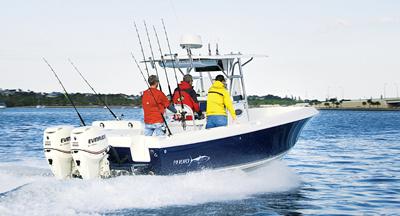
Props, Tops and Trim
We get tons of mail about which propellers are best for a particular boat. Unlocking the secrets of fuel efficiency on our Bluewater 2550 can give you insight for correctly propping your own boat. “Props are important to efficiency,” deadpanned Mike Rogge, senior engineering technician for Evinrude and our prop specialist for this test. His no-nonsense delivery and demeanor confirmed our instinct to test the effects of props on fuel burn with him.
It’s important to note that the primary criterion for selecting a propeller is to make sure it allows the engine to “turn up” to a speed within the band designated by the manufacturer — usually within 500 revolutions of absolute top rpm. This ensures a long life for the engine, neither lugging it down nor letting it over-rev. But within that band, you can select a variety of props that will allow the engine to turn up, yet have differences in pitch and number of blades, plus possess more subtle characteristics such as rake, skew and cup. Evinrude offers demo props through participating dealers for the purpose of allowing their customers to pick the best props for their needs.
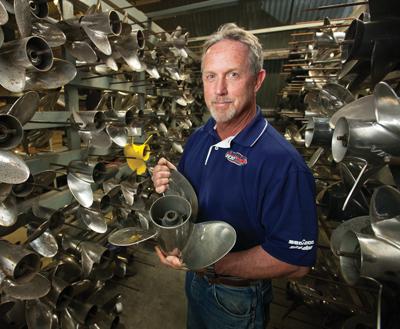
Our Bluewater was run and turned up with eight different stainless-steel propellers. Not only did fuel consumption vary wildly, but also the thirstiest set of wheels allowed the engines to rev up only to the low end of the range specified by the manufacturer. The most fuel-saving wheels allowed the motors to rev to near the maximum of that range, however, meaning they’ll not only save dinero at the pump, but will also pay dividends in increased long-term durability and reliability.
So, the right prop matters, meaning it’s worthwhile to beg, borrow or steal a selection to try out on your boat. What else can help improve your boat’s efficiency?
Optimum Trim
“You’ll never have optimum fuel economy if you don’t use optimum trim,” says Steve Kocourek, Evinrude senior engineering technician. Testing bore out the veracity of Kocourek’s statement. During extensive discussion he hammered home the fact that trimming out reduces the wetted surface of the hull by raising the bow. How do you know if you’re trimmed for efficiency? “Trim out until the prop ventilates a little (sucks air). Then bring it down a little,” Kocourek says.
T-Tops, Hardtops, Towers
Not every technique we tested saves as much fuel as does spinning the right prop or optimizing trim. Canvas enclosed T-tops, hardtops, towers and Bimini tops all create aerodynamic drag, causing the engine to work harder to make the boat go any given speed. Over the course of my career I’ve tested boats with the canvas up and the canvas down, and I’ve seen enclosures scrub as much as 3 mph off of a boat’s speed. interestingly, some T-tops actually enhance efficiency: They act as a wing and create lift. But once you put canvas on, life’s a drag once again.
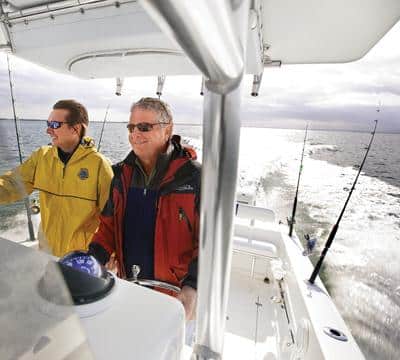
Even something as simple as opening or closing a split windshield can affect how much go-juice the engine drinks. Our Bluewater’s top wasn’t removable, nor was it fitted with canvas, so we jumped into the first Chaparral 327 SSX bowrider to come off the line (read a full review) and tested it with the split windshield open and closed. Then we compared the results. This time, the economy was better with the windshield open, but for most bowriders, closing the windshield results in greater speed at a given rpm and, thus, better efficiency. Try your boat both ways, monitoring tach and speedo, to see what’s best.
OK, so you won’t be repowering with the money saved by closing or opening a windshield. Fuel economy is improved by a combination of tactics that incrementally add up to less fuel burned.
Pounds = A Real Drag
Weight is another story. We boaters are all guilty of carrying too much gear aboard. it accumulates one lure, one ski and one gadget at a time, during months and years of boating. One of the quickest ways to get more miles per gallon is to get the lead out! No, don’t leave the dock without tools, spares or safety equipment, and don’t go so far as to drink your sundowner neat instead of on the rocks. But don’t stow the fishing gear aboard when the season is over, the water skis and wakeboards when your kids are back at school, and the 12 cases of fizzy stuff here and there “just because.” That stuff has got to go if you want to save more fuel.
To prove the point, we loaded the Bluewater with a crew of seven and all the gas and water we could carry. Check the chart below for the dismal results.
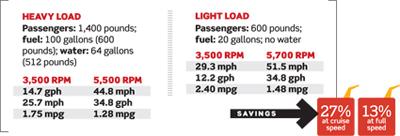
Next, we ran the Bluewater “light.” We drained the fuel down to 20 gallons. We stripped it of every bit of gear but for required safety equipment — and, yes, discovered we had more on board than we’d need on any three fishing trips. Then we set out with a three-man crew weighing 600 pounds and increased our economy by a whopping 27 percent.
Such a dramatic increase isn’t likely in normal use, since few boaters will either strip or weight their rigs to the extremes that we did for testing. Put in terms you can use, we added 1 percent to our cruise-speed efficiency for every 100 pounds we took off the boat. if this boat were run 100 hours a year, we’d save 16 gallons annually for every hundred pounds we didn’t carry. If you’re shopping for a boat, compare displacement carefully when deciding between models if maximized fuel economy tops your priorities. Ditto for comparing the weights of engines. Hundreds of pounds will cost you hundreds of dollars.
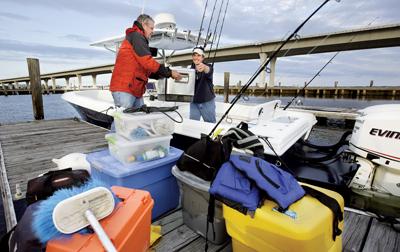
Later Craters
Also, “a clean, smooth bottom is a real efficiency enhancer,” says product manager Karl Sandstrom, a 21-year Evinrude veteran. If you keep your boat at a slip or mooring, use a quality bottom paint. Traditional “hard” paints are effective anti-foulants, but they create a cratered surface after a few years of built-up coats. If your boat’s bottom looks like the Sea of Tranquility, break out a scraper, or hire a bead blaster to remove that old cratered paint. Efficiency mavens select ablative paints, such as Interlux Micron or Pettit Hydrocoat. These wear away, leaving a smooth surface. If your boat has sat idle for a while, it pays to hire a diver to scrub the bottom or to don a mask and fins and do it yourself.
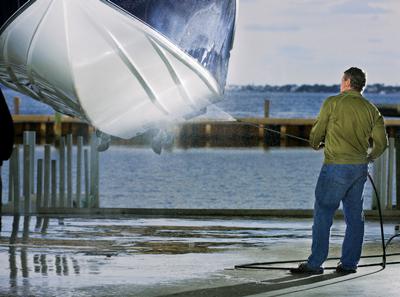
Of course, keeping an engine in top shape counts toward the economy total. Adhere to the maintenance schedule in the owner’s manual. Send the prop out for reconditioning if you bend a blade. (Or learn to coax dings back to normal with file, mallet and the judicious application of double-wrenching.) The recipe for maximized efficiency is like stew, rich with many ingredients that add up to something good. Apply the techniques we tested, and watch your fuel gauge move slower and slower and slower.
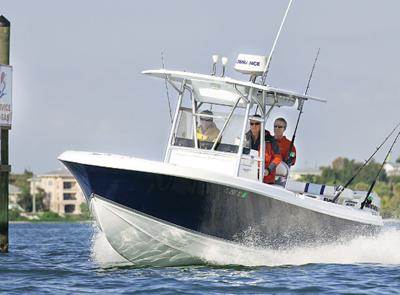
Proving-Ground Procedures
Our guinea pig was a 25-foot Bluewater 2550 center console, powered by twin 200 Evinrude E-TEC outboards. Our battery of tests were run in salt water, measuring fuel burn using Evinrude I-Command NMEA 2000 instruments reading directly from the engines’ electronic control modules. Speeds were recorded from a Lowrance LCX-26 GPS. All runs were done in two directions, to negate the effects of wind and current.
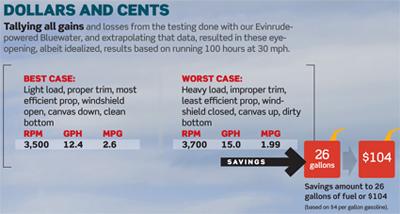
Dollars and Cents
Tallying all gains and losses from the testing done with our Evinrude-powered Bluewater, and extrapolating that data, resulted in these eye-opening, albeit idealized, results based on running 100 hours at 30 mph.
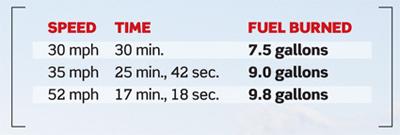
Back Off, Burn Less
Simple but true: Back off the throttle to burn less fuel. Naturally we don’t expect you to troll everywhere, but unless you’re in a tournament, are racing to make a bridge opening or have that momentary need for speed that afflicts us all, slow down to save fuel without costing any real time. Check out the 15-mile run numbers from our Bluewater test boat (shown above).
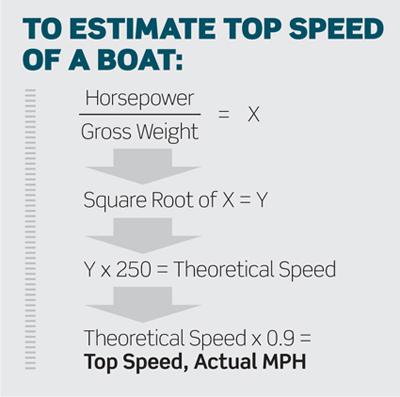
Do You Know It Takes…
2 gallons of crude oil to make 1 gallon of gasoline
26 pounds of corn to make 1 gallon of ethanol
1/2 pound of fuel to make 1 horsepower per hour
1 gallon of gasoline = 6 pounds
1 gallon of diesel = 7 pounds









